Two exhibitions installed across the Seine from each other this past summer used versions of the same artworks—two eighteenth-century French tapestries from the royal series known as the Nouvelles Tentures des Indes— to tell very different stories about European legacies of race, slavery, and colonialism. One version, from a set woven in 1795, hangs in the lavish period rooms of the new Hôtel de la Marine in the Place de la Concorde, while another, created decades earlier, was part of a contemporaneous exhibition devoted to the Congolese artist Sammy Baloji (b. 1978) at the École des Beaux-Arts (Fig. 1, 2). Despite the fact that both sets of tapestries were taken from the Mobilier National, and the two venues are only a short walk from each other, no one seems to have commented on the coincidence. Considered together, they raise important questions about the role of museums and exhibitions in reconstructing the past, while also suggesting possible ways for artists and scholars to help make history relevant for the present.
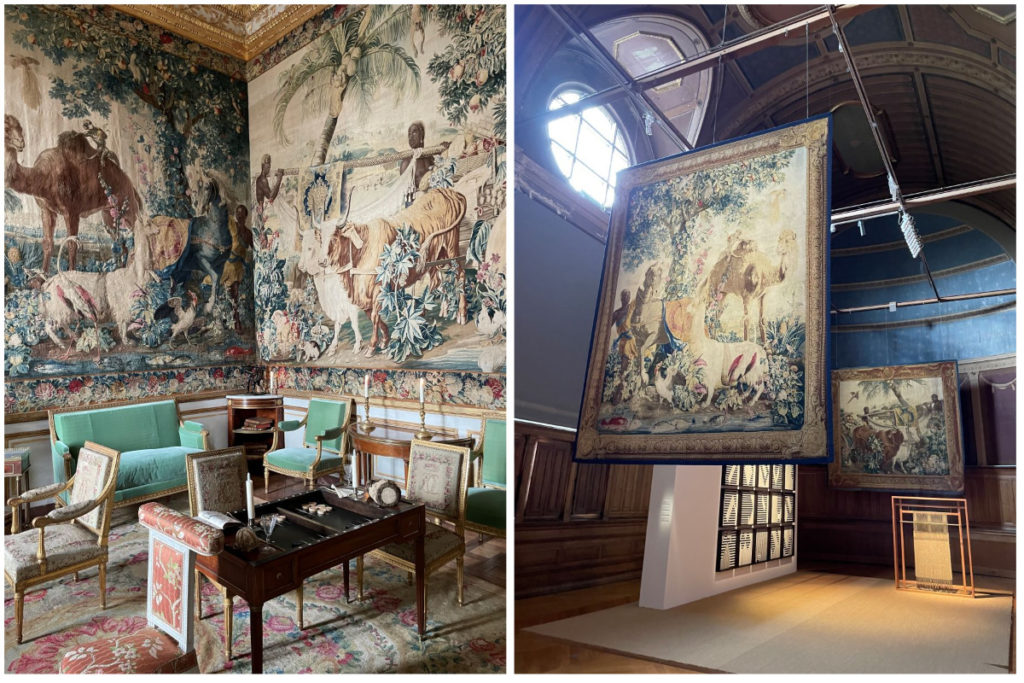
Right: Fig. 2. View of the exhibition Sammy Baloji – K(C)ongo, Fragments of Interlaced Dialogues at the École des Beaux Arts. Photo by author.
The newest member of France’s Centre des monuments nationaux (CMN), the Hôtel de la Marine opened in June 2021 after a multiyear, 132 million euro renovation funded by a loan based on projected visitor income as well as support from donors like Qatar’s ruling Al Thani family, who will display some of its collection on the ground floor. The building will also house the Académie de la Marine, a scholarly body devoted to maritime research; the Fondation pour la mémoire de l’esclavage (Foundation for the Remembrance of Slavery), established in 2016; and the offices of FIFA, the International Federation of Association Football. These strange bedfellows suggest the contested politics behind the project, which include three French presidents (Sarkozy, Hollande, and Macron) with divergent agendas; protests from the far right over the possibility of establishing a museum of slavery; and the CMN’s own indecision over whether to foreground the history of taste, gastronomy, or simply la France—not to mention the usual financing challenges.
The ultimate result of these disputes, the Hôtel de la Marine is housed in one of the neoclassical palaces designed around 1750 by Ange-Jacques Gabriel as part of a grand square honoring Louis XV, repurposed during the French Revolution into an execution ground for Louis XVI and Marie-Antoinette. During the eighteenth century, the building housed the royal furniture repository or Garde-Meuble, ancestor of the Mobilier National. Two of the Garde-Meuble’s noble intendants, Pierre-Élisabeth de Fontanieu (1730-1784) and Marc Antoine Thierry de Ville-d’Avray (1732-1792), lived on site in an elegant suite of rooms that have been meticulously if somewhat fancifully restored by a team of “cultural heritage” artisans working under the CMN and the interior decorators Joseph Achkar and Michel Charrière.[1]
The intendants’ quarters comprise the Marine’s “Age of Enlightenment” tour circuit, which is part of its comprehensive “Grand Tour.” The Grand Tour includes a visit to nineteenth-century reception rooms that are part of the building’s post-Revolutionary history. After 1789 (and until 2015), the palace served as headquarters of France’s Navy Ministry, responsible for overseeing the navy as well as French ports, colonies, and foreign commerce. The building became the site of naval planning but also of lavish balls celebrating Napoleon’s 1804 coronation and other imperial victories, a few of which are virtually reenacted on the “Dancing Mirrors” that grace the Salon d’honneur, the largest of these galleries.
Beyond this space, in an out-of-the-way side room, historical figures associated with the navy are featured in an interactive “Table of Sailors” that is part of the museum’s “Travelling through Time” didactic display. Through digital maps, images, and voiceovers, visitors learn about the exploits of such “remarkable” French seafarers as Abraham Duquesne (1610-1688); Jeanne Baret (1740-1807); Jean-François de Galaup, comte de Lapérouse (1741-1788), whose name graces the museum’s swank restaurant; and Guy-Victor Duperré (1775-1846), commander of the French fleet during the 1830 invasion of Algiers. They also learn about Jean-Vincent Morice (1725-1788), a Breton slave trader whose story provides an opportunity to “hear” the voices of an enslaved woman named “Aisha” and an unnamed French sailor on board La Digue, a slaving ship on which Morice sailed in 1772 to buy, transport, and sell 230 enslaved Africans to France’s Caribbean colony of Saint-Domingue. The voiceover ends by invoking the drafting of a decree to abolish slavery in France and its colonies in 1848, an event that took place in this same building.
The high-tech virtual displays that accompany visitors throughout these nineteenth-century galleries are absent in the intendants’ quarters. Both parts of the Grand Tour, however, feature the “Confidant,” an immersive headset with binaural sound that uses the voices of actors impersonating real-life or fictional historical characters to bring these eighteenth-century period rooms and their former inhabitants to life. The overall mise-en-scène, furthermore, aims to give the impression of aristocratic occupants who have only just left the building, with piles of books open on the table, candles lit, ice chilling in the porcelain wine cooler, and oyster shells tossed amid empty bottles and glasses on the floor (Fig. 3).
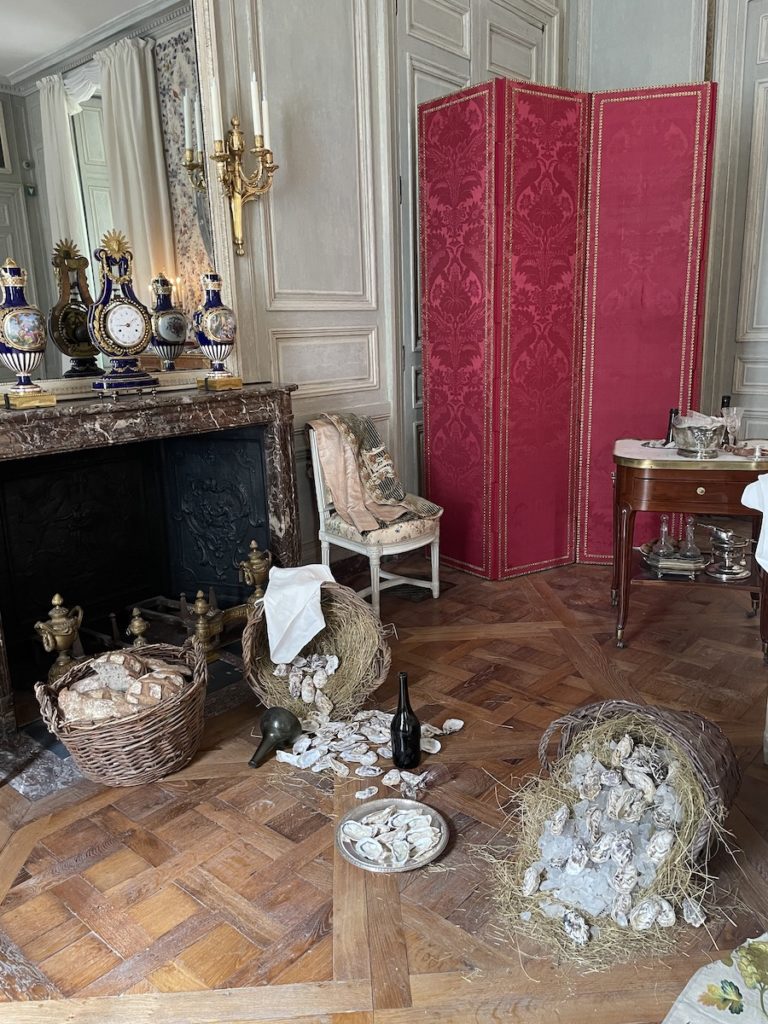
This “Night at the Museum” effect is notably apparent in the Salon d’angle, described in the voiceover as “the most sumptuous room in the apartments, worthy of royal residence” (Fig. 1). Scattered atop its tables are playing cards and chips suggesting that gambling, an elite pastime intrinsically linked to global capitalism, has just taken place, and the knowing voices of the Confidant confirm that gambling was indeed “so much a part of a refined soiree. Here flourished the life of the worldly.” Lest visitors assume, however, that the room was only used for profligacy, the audioguide characters—who include the famed salonnière Madame Necker (1737-1794), wife of Louis XVI’s finance minister—begin to discuss the Encyclopédie (1751-1765), reminiscing that it was in Parisian salons like this that such quintessentially “Enlightenment” projects were launched.
During their brief exchange, the characters refer to the salon’s fashionable “wall hangings” and “costly” fireplace with its “ravishing” rams’ heads, but in general they say little about the décor, and there are no wall labels, plaques, or QR codes to inform visitors about the room’s contents. Presumably, this lack of information is meant to maintain an illusion of smooth, immersive time traveling. However, the actual effect of silence, for this visitor at least, was jarring, especially given the building’s history and current status as a site of public education, maritime research, and remembrance.
From the moment visitors enter this space (judging by my own visit), their eyes immediately go to the vibrant wall hangings, which depict enslaved African laborers and animals in an exotic landscape. An enslaved man looks up and back in the direction of the room, where the bust of a Black woman, made of lacquered bronze and wearing a gilded turban, rests on the mantelpiece (Fig. 4). The sculpture is a musical automaton clock, one of several French clocks portraying African bodies from the late eighteenth and early nineteenth centuries—a period that coincided with France’s first, temporary abolition of slavery (from 1794-1802), but also with maritime and colonial advancement made possible by navigational technologies associated with time-keeping.[2] When, in 1784, the clock’s creator Jean-André-Baptiste Furet displayed a version of it in his shop on the nearby rue Saint-Honoré, and even more so after Thierry de Ville d’Avray paid 4,000 livres (approximately 250,000 euros) to acquire it for the royal family, the clock became all the rage among the French court, owing partly to its time-telling capabilities. When one of the woman’s earrings is pulled, her right eye rolls to the hour, while her left eye reveals the minutes. When her other earring is pulled, the sound of music emanates. The fact that the version belonging to the French royal family had to be repaired three separate times during the late eighteenth century suggests the eagerness with which its owners performed this violent gesture: one that evokes not so much “time traveling” as time-discipline associated with enslaved labor and the plantation system.[3]
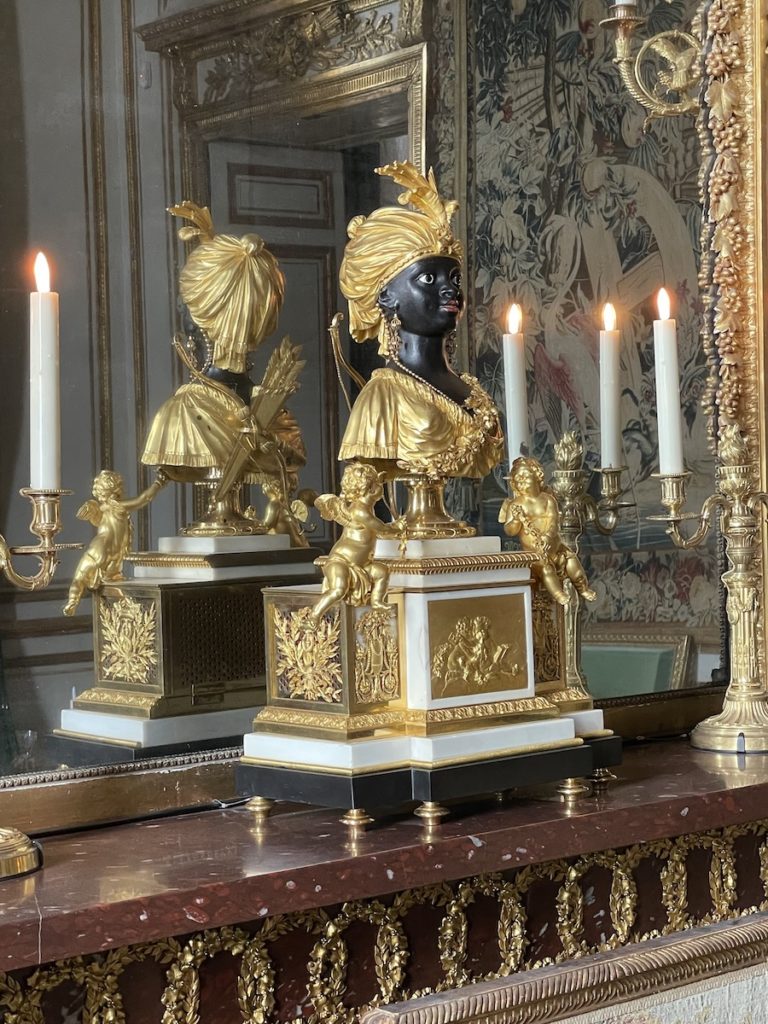
The enslaved figures on the walls go back further in time, and their history is multilayered. Known as Les Deux Taureaux (The Two Bulls) and Le Chameau (The Camel), these two tapestries were produced from eight designs that France’s finance minister and arts administrator Philibert Orry commissioned from Alexandre-François Desportes in 1735. Shown at the Paris Salons of 1737, 1738, 1740, and 1741, Desportes’s studies were turned into tapestries that were rewoven multiple times throughout the eighteenth century, and may have been the most successful (in quantitative terms) that the Gobelins ever produced.[4] As noted above, these examples are from a Revolutionary-era set woven in 1795, one year after slavery was temporarily abolished and four years after the outbreak of revolution in Saint-Domingue (which became Haiti in 1804). They did not actually hang in this room during the eighteenth century but were added by the Hôtel de la Marine’s decorating team, reportedly because they fit the dimensions of the space. A 1797 inventory of the Garde-Meuble’s collections does list two Gobelins tapestries “dites des Indes” (said to be from the Indies), but it isn’t clear that they were these two, or that they were even from the Nouvelles Indes series. “Indes” was a notoriously slippery term in early modern Europe, sometimes used to bring different “exotic” parts of the world into the same conceptual and imperial framework, or to suggest an intentionally vague “elsewhere” that fueled commercial and colonial fantasies.[5]
Simon Shaw has shown how Desportes and his royal patrons sought to capitalize on this exotic indeterminacy to appeal to French audiences whose visions of global maritime ascendancy were not met in practice.[6] Desportes’s designs were inspired by an earlier Gobelins series known as the Anciennes Indes, first woven in 1687—two years after the establishment of the Code Noir, which regulated slavery in the French colonies and defined enslaved humans as “meubles” (moveable property)—and rewoven seven additional times by 1730.[7] The Anciennes Indes were based on studies by the Dutch artist Albert Eckhout, who, along with the painter Frans Post, had accompanied Johan Maurits to Brazil in 1637, when Maurits took over as governor-general of the Dutch colony there. Years later, Maurits presented the cartoons and other paintings by Eckhout and Post as a gift to Louis XIV and urged the Sun King to transform them into tapestries that likewise “aimed at making tangible the possibility of colonial conquest.”[8]
The creation of both the Anciennes Indes and the Nouvelles Indes entailed transposing Eckhout and Post’s idealized vision of the Dutch presence in Brazil and South America to an even more fanciful image of France’s New World dominance. Among Desportes’s modifications to the earlier series were the swapping out of various flora and fauna, some of which resided not in Brazil but in the French royal menagerie, and the omission of a Mapuche rider in an Anciennes Indes tapestry known as L’Indien à Cheval (The rider had alluded to a 1643 Dutch expedition to Chile; Desportes opted to remove this Indigenous presence and put a more generically and incongruously exotic camel in his place, see Fig. 2).[9] Desportes did not have to change much, however, to prompt viewers of the late 1730s to connect these exotic scenes to France’s colonial possession of the Caribbean, given the depiction of enslaved Africans and the piles of cut sugar cane loaded into the ox-cart in Les Deux Taureaux (Fig. 5). This cart, along with the sugar mill in the background, may have been lifted from paintings by Post, but by the late 1730s these motifs more readily conjured Saint Domingue and other New World colonies that had enabled France to dominate the world sugar market[10]—even as they glossed the horrific labor conditions and violence that took place there.
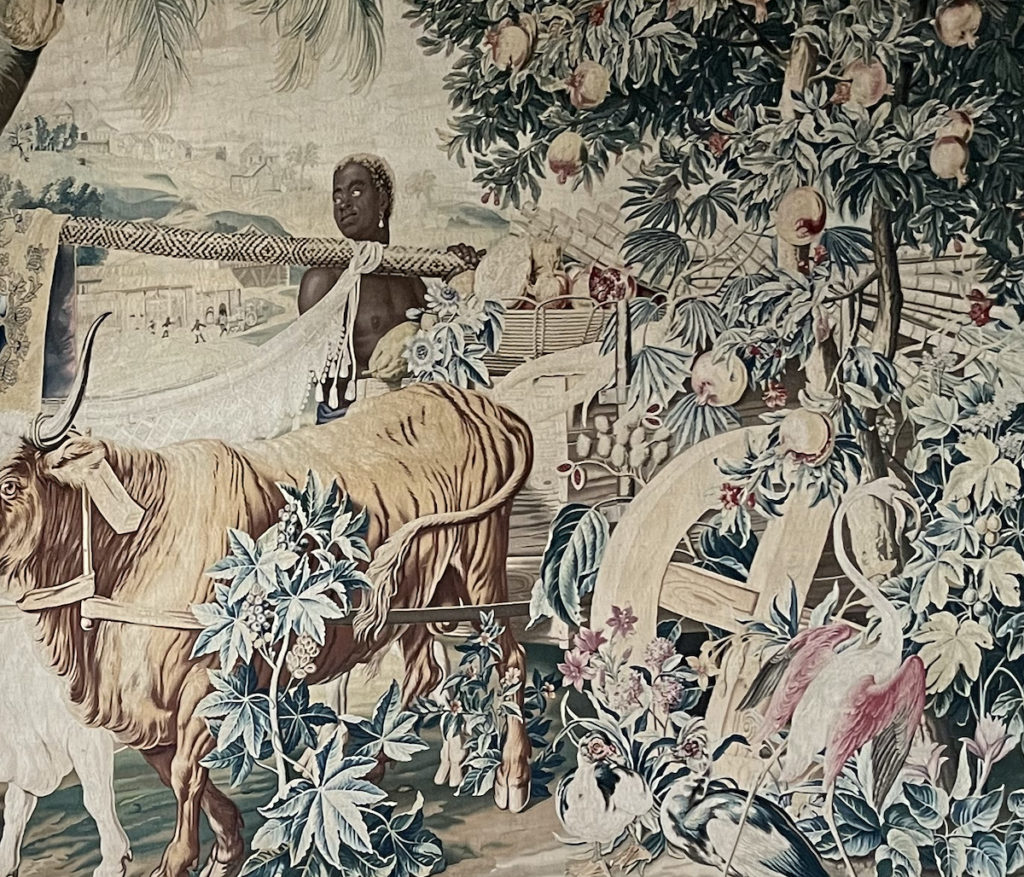
One of the most fascinating historical erasures from these tapestries involved the presence of Kongo emissaries in Brazil during Maurits’s tenure.[11] In 1642, the ruler of Soyo, a province of the Kingdom of Kongo, sent an ambassador and his entourage to solidify an alliance with the Dutch against the Portuguese, and in oil studies Eckhout captured details of their appearance, dress, and regalia that made their way into his tapestry cartoons. Vestiges of this Kongo connection linger in the one-shoulder garments worn by the enslaved men in the Hôtel de la Marine tapestries and in the hammock carried by the Black porters in Les Deux Taureaux, which served as a “visual shorthand” for Kongo culture in early modern European prints.[12]
While these references may not have been noted by eighteenth-century French viewers—or visitors to the Hôtel de la Marine today—they are the focus of Sammy Baloji’s Beaux-Arts exhibition, which featured earlier versions of these same two tapestries along with other examples from the Anciennes Indes and Nouvelles Indes (Fig. 2). Born in Lubumbashi, the mining capital of the Democratic Republic of the Congo, and based there and in Brussels, Baloji creates archivally-driven, multi-media installations that explore the history and memory of the Congo, especially under Belgian colonial rule. As he has said, he is “not interested in colonialism as a thing of the past, but in the continuation of that system,” particularly as it pertains to technology and industry, resource extraction, and labor exploitation. Last year, he was invited by the Festival d’Automne and the Beaux-Arts to present his first solo exhibition in Paris. The result, the one-room installation Sammy Baloji – K(C)ongo, Fragments of Interlaced Dialogues, includes work he made while he was a resident at the Villa Medici, descendant of the eighteenth-century French Academy in Rome, and home to a set of Nouvelles Indes tapestries.
While in Rome, Baloji researched early modern exchanges among the Kongo kingdom, Portugal, and the Vatican, as manifested by the slave trade and by the dispersal of elite Kongolese textiles and other art objects in European collections. Inspired by the display of raffia textiles in The Metropolitan Museum of Art’s Kongo: Power and Majesty exhibition in 2015, Baloji made negatives of these pieces and cast them in bronze, a copper alloy that for him embodies the Congo’s colonial past and neocolonial present, notably in the copper mining town where he grew up.[13] At the École de Beaux-Arts, some of these works hung on a white wall, lit with a spectral glow, next to the Nouvelles Indes tapestries La négresse portée and Le combat d’animaux (Fig. 6). Their juxtaposition highlighted, on the one hand, two cultural traditions that valued textile manufacture and artisanal skill as important expressions of power and prestige. But it also underscored how the origins and identities of these objects and the peoples represented on them became lost over time, as they acquired new meanings in new contexts.[14]
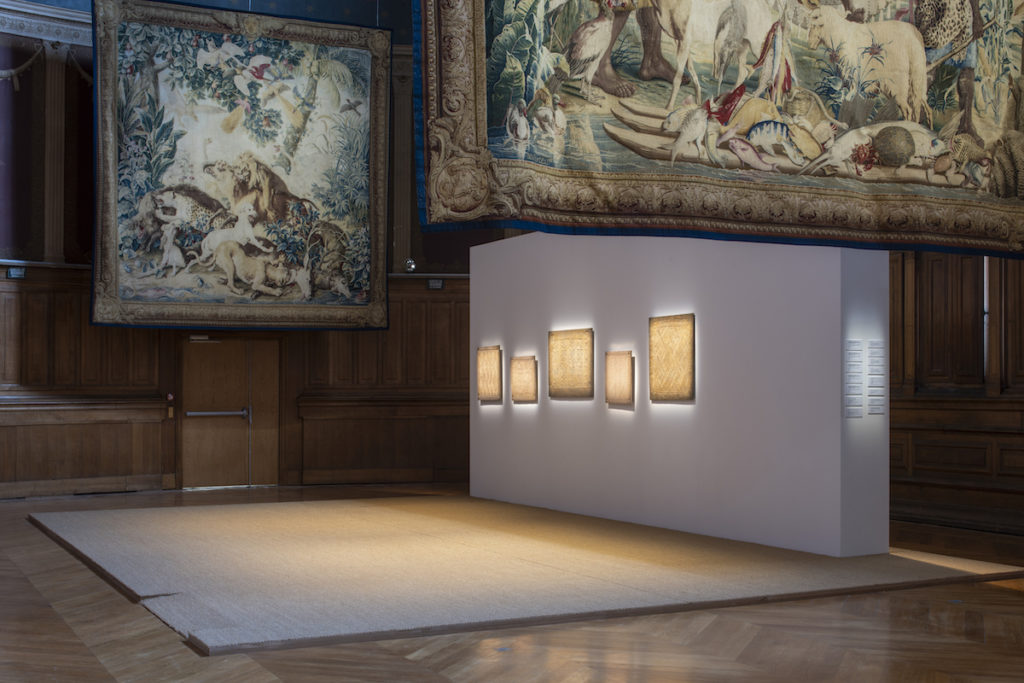
On the other side of the room hung the earlier versions of Le Chameau and Les Deux Taureaux installed next to two works by Baloji: another copper weaving (made in collaboration with Estelle Chatelain), and a series of black and white drawings whose patterns replicate those of the raffia textiles (Fig. 2).[15] The title of this series, Mfuba’s Extract. Wunderkammer (work in progress), refers to the European cabinets of curiosity into which Kongolese textiles were first displaced, while their graphic, “kinetic” appearance (to use Baloji’s own term) is intended to activate or animate these historical artifacts so as to encourage a new way of looking at them. Elsewhere in the room, the artist attempted a similar reframing in the form of painted wooden panels whose Congolese patterns and motifs—along with Congolese raw materials like wood, copper, and ivory—were appropriated by the Belgian Art Nouveau movement and used to ornament the colonial exhibition pavilion that became the infamous Royal Museum for Central Africa in Tervuren outside of Brussels (Fig. 7). The vivid colors of these panels, meanwhile, pay homage to abstract colored diagrams that W.E.B. Du Bois employed in his “American Negro Exhibition” of 1900, which later inspired avant-garde European art movements like Russian Constructivism and De Stijl. By dynamically bringing these artworks and historical references into dialogue with each other, Baloji foregrounds the unacknowledged debt that early modern and modern art—and modernity—owe to African sources, materials, and bodies.[16]
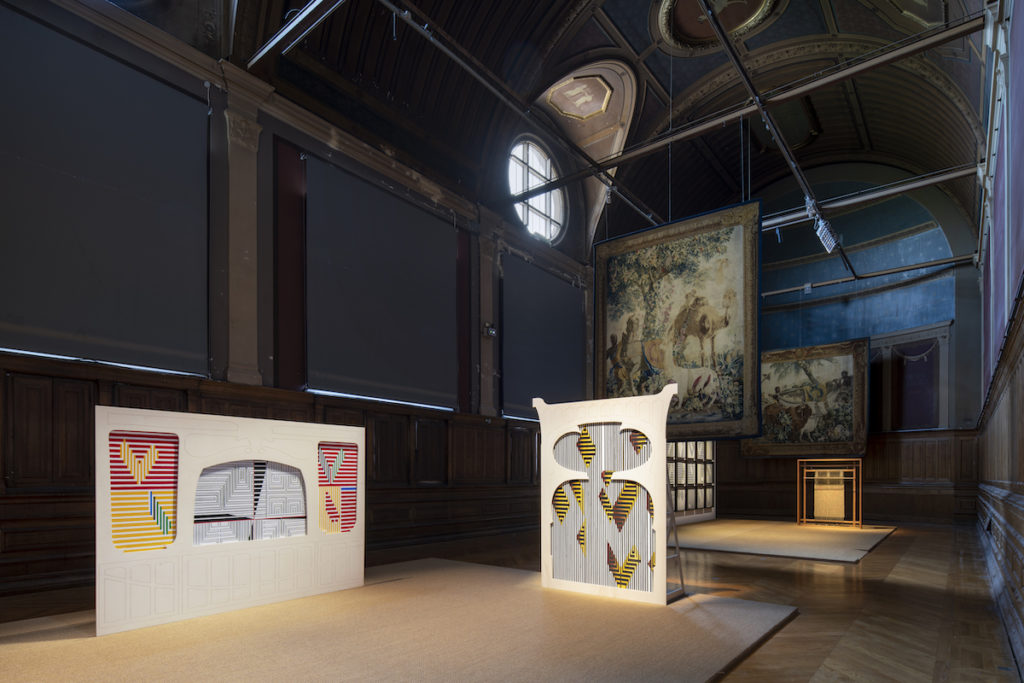
In an essay she wrote to accompany the Beaux-Arts show, Anne Lafont notes how Baloji “interweave[s] time, media, and artworks” so that we might “see and rethink our relationship to art objects and to history.”[17] On some level, this aim resonates with the Hôtel de la Marine’s mission to bring visitors “on an all-round trip through time,” to “breathe life into the various areas” of the building, and to “expand [a visitor’s] knowledge of history.” And yet the Marine has opted for a particular and partial view of history, one that trades on a myth of the manifold glories and pleasures of the ancien régime without acknowledging the forced labor and suffering that enabled its “worldly” elite society to “flourish.” Perhaps the choice to create a “mini-Versailles” in Paris was driven by revenue concerns, but it would seem to underestimate (if not outright offend) visitors to assume that they could not hear multiple sides of the story, or could not break their “immersive” reverie to learn more about the objects and subjects depicted and their role in shaping the history to which the museum is dedicated.
This history could be linked in turn to the exotic materials employed throughout the palace—Saint-Domingue mahogany for the floors and furnishings, African ivory for the intendant’s lathe on view in another room—as well as to the “Table of Sailors” and, above all, to the “Remembrance of Slavery” foundation in the building. (In fact, two members of the foundation’s scientific committee, Lafont and fellow art historian Cécile Fromont, both of whom collaborated with Baloji on his Beaux-Arts show, were not consulted about the Marine’s reconstruction.) It is not just ironic but a sorely missed opportunity to mention the wall hangings in the audioguide for this Garde-Meuble interior while saying nothing about the enslaved figures (or “meubles”) portrayed on them—and, even more so, to do it while music from the Les Sauvages section of Jean-Philippe Rameau’s 1735 opéra-ballet Les Indes Galantes plays in the background. Performed the same year the Nouvelles Indes was commissioned, Les Sauvages was inspired by a 1725 performance at Paris’s Théâtre Italien of two Indigenous male dancers, part of a delegation of Otoe, Missouria, Osage, and Michigamea men and women brought to France via the French colony of Louisiana.[18] In 2019, it was also the focal point of a powerful reimagining of Les Indes Galantes for the Paris Opéra, led by the artists Clément Cogitore and Bintou Dembélé.
Baloji’s exhibition was only up for five weeks in a summer still plagued by Covid, which could partly explain why its connection to the Hôtel de la Marine appears to have gone unnoticed. As for the Marine, the enthusiastic response in the press thus far has focused mainly on its elaborate passementerie and other period “trimmings,” eliding the problematic aspects of the display. My intention here is not to rebuke the Marine but rather to suggest the possibility of fostering greater dialogue between the CMN and the French and Francophone artists and scholars whose work on race, slavery, and colonialism is deeply relevant to its heritage sites. Might it be possible, for instance, to interweave these two presentations of the New Indies across the Seine—to bring some of the insights from Baloji’s installation into the permanent galleries of the Marine, even if only as a supplement to the audioguide or a plaque on the wall or guardrail? In a final irony, Baloji, in collaboration with the Nigerian artist Emeka Ogboh, was recently named a finalist to design a French memorial to the victims of slavery that will be erected in the Tuileries Gardens, in the shadow of the Marine and a short walk from Baloji’s Beaux-Arts display. The project is currently stalled and the selection committee is soliciting new proposals, so the finalists will likely have to resubmit and the project will be further delayed. In the meantime, perhaps it would be possible to engage Baloji or another artist to “recontextualize” the eighteenth-century rooms at the Hôtel de la Marine, to help bridge the gap between two thought-provoking shows that were materially and physically so close but conceptually worlds away.
Meredith Martin is Associate Professor of Art History at New York University and a founding editor of Journal18
Acknowledgments: I wish to thank Boris Atrux-Tallau, Guillaume Calafat, Cécile Fromont, Anne Lafont, Simon Shaw, the communication and education offices of the Hôtel de la Marine, and my fellow Journal18 editors. A shorter version of this essay appeared in Artforum.
[1] Unless otherwise indicated, the phrases put in scare quotes throughout this essay are taken from the Hôtel de la Marine’s website or its press release. See also the July 2021 issue of the Connaissance des arts devoted to the Hôtel de la Marine, and Alexandre Gady, Hôtel de la Marine (Paris: Éditions du patrimoine, Centre des monuments nationaux, 2021).
[2] Anne Lafont, L’art et la race: L’Africain (tout) contre l’oeil des Lumières (Dijon: Les presses du reel, 2019), 288-311. See also Stephanie O’Rourke’s review of Lafont’s book in Journal18, https://www.journal18.org/nq/art-and-race-a-review-by-stephanie-orourke/ (accessed August 12, 2021).
[3] Lafont, L’art et la race, 293. See also the online description of another example of this clock in the collection of The Metropolitan Museum of Art.
[4] The history of this tapestry series and its predecessor, the Anciennes Indes (see below), is explored in Exotismus und Globalisierung: Brasilien auf Wandteppichen: die Tenture des Indes, ed. Gerlinde Klatte, Helga Else Frieda Prüssman-Zemper, and Katharina Schmidt-Loske (Berlin: Deutscher Kunstverlag, 2016). See also Charissa Bremer-David, “Le Cheval Rayé: A French Tapestry Portrating Dutch Brazil,” J. Paul Getty Museum Journal 22 (1994), 21-30; and Simon Shaw, “(Re)producing America: Desportes’ Nouvelles Tentures des Indes,” MA Thesis, Courtauld Institute of Art, 1996. Shaw notes the quantitative success of the series on p. 4.
[5] See, for example, Jessica Keating and Lia Markey, “’Indian’ Objects in Medici and Austrian-Habsburg Inventories: A Case-Study of the Sixteenth-Century Term,” Journal of the History of Collections 23:2 (November 2011), 282-300; and Ashley L. Cohen, The Global Indies: British Imperial Culture and the Reshaping of the World, 1756-1815 (New Haven: Yale University Press, 2021).
[6] Shaw, “Re(producing) America.”
[7] Bremer-David, “Le Cheval Rayé,” 10. Desportes had been hired twice by the Gobelins (in 1692-1693, and again in 1722) to repair the cartoons for the Anciennes Indes, which had deteriorated due to overuse. His work on this earlier series was likely a factor in giving him the Nouvelles Indes commission.
[8] Carrie Anderson, “The Old Indies at the French Court: Johan Maurits’s Gift to Louis XIV,” Early Modern Low Countries 3 (2019), 1, 32-59.
[9] See the essays by Katharina Schmidt-Loske and Monika Lodderstaedt-Dürr in Exotismus und Globalisierung, ed. Klatte, Prüssman-Zemper, and Schmidt-Loske. The omission of Indigeneity as a trope of colonialist image-making is discussed in Krista A. Thompson, An Eye for the Tropics: Tourism, Photography, and Framing the Caribbean Picturesque (Durham and London: Duke University Press, 2006), especially p. 63.
[10] Madeleine Dobie, “Orientalism, Colonialism, and Furniture in Eighteenth-Century France,” in Furnishing the Eighteenth Century: What Furniture Can Tell Us about the European and American Past, ed. Dena Goodman and Kathryn Norberg (London: Routledge, 2007), 13.
[11] Cécile Fromont, The Art of Conversion: Christian Visual Culture in the Kingdom of Kongo (Chapel Hill: University of North Carolina Press, 2017), chap. 3. On p. 153, Fromont cites a French royal inventory indicating that this erasure had already begun to occur by 1690. See also the French edition, L’Art de la Conversion – Culture visuelle chrétienne dans le royaume de Kongo (Dijon: Les presses du réel, 2018), which features the Anciennes Indes tapestry Le Roi porté par deux maures on its cover.
[12] Josiah Blackmore (with contributions by James Green), “European Images of the Kongolese in Books,” in Kongo: Power and Majesty, ed. Alissa LaGamma, exh. cat. (New York: The Metropolitan Museum of Art, 2015), 119-126.
[13] This information is taken from a dossier prepared by Baloji’s Paris gallery, Imane Farès, in connection with his Beaux-Arts show.
[14] Anne Lafont makes similar points about textile manufacture and the “redistribution” of human beings and art objects in the short essay she wrote to accompany Baloji’s show, entitled “Enchâssements. Of Frames and Times,” available as a PDF here.
[15] As mentioned earlier, the two tapestries in Baloji’s show also came from the Mobilier National, inv. GMTT-185-003 (woven 1740-1741) and IAT-56-000.
[16] For descriptions of all of the works in the Beaux-Arts exhibition, see the Imane Farès dossier (n. 13), as well as https://imanefares.com/en/artistes/sammy-baloji/oeuvres/ (accessed August 12, 2021). See also Debora L. Silverman, “Diasporas of Art: History, the Tervuren Royal Museum for Central Africa, and the Politics of Memory in Belgium, 1885-2014,” The Journal of Modern History 87:3 (September 2015): 615-667; and Annette Gordon-Reed, “The Color Line,” The New York Review of Books, August 19, 2021: https://www.nybooks.com/articles/2021/08/19/du-bois-color-line-paris-exposition/ (accessed August 23, 2021).
[17] Lafont, “Enchâssements” (n. 17). Lafont and Cécile Fromont discuss this aim with Baloji in a conversation filmed at Paris’s Institut des études avancées in June 2021.
[18] Olivia A. Bloechl, “Rameau’s Les Sauvages and the Aporia of Musical Nature,” in Native American Song at the Frontiers of Early Modern Music (Cambridge: Cambridge University Press, 2008), chap. 7 (especially p. 188). Whereas Bloechl writes that the dancers were probably Natchez or Choctaw” (p. 195), Garrett Wright has associated them with the 1725 delegation in Paawaarihusu: Travel and the Central Great Plains (PhD dissertation, University of North Carolina Chapel Hill, 2019), 92-94. As Wright points out, the dance is mentioned in the September 15, 1725 issue of the Mercure de France, but the Mercure only describes the dancers as being “large and well-built, and [about] 25 years old,” without any further information.
Cite this note as: Meredith Martin, “Left Bank/Right Bank: Two Views of the “Indies” in Paris,” Journal18 (September 2021), https://www.journal18.org/5812.
Licence: CC BY-NC
Journal18 is published under a Creative Commons CC BY-NC International 4.0 license. Use of any content published in Journal18 must be for non-commercial purposes and appropriate credit must be given to the author of the content. Details for appropriate citation appear above.

Pingback: Smell of the Sea: A Review of the Musée National de la Marine – by Kelly Presutti – Journal18: a journal of eighteenth-century art and culture